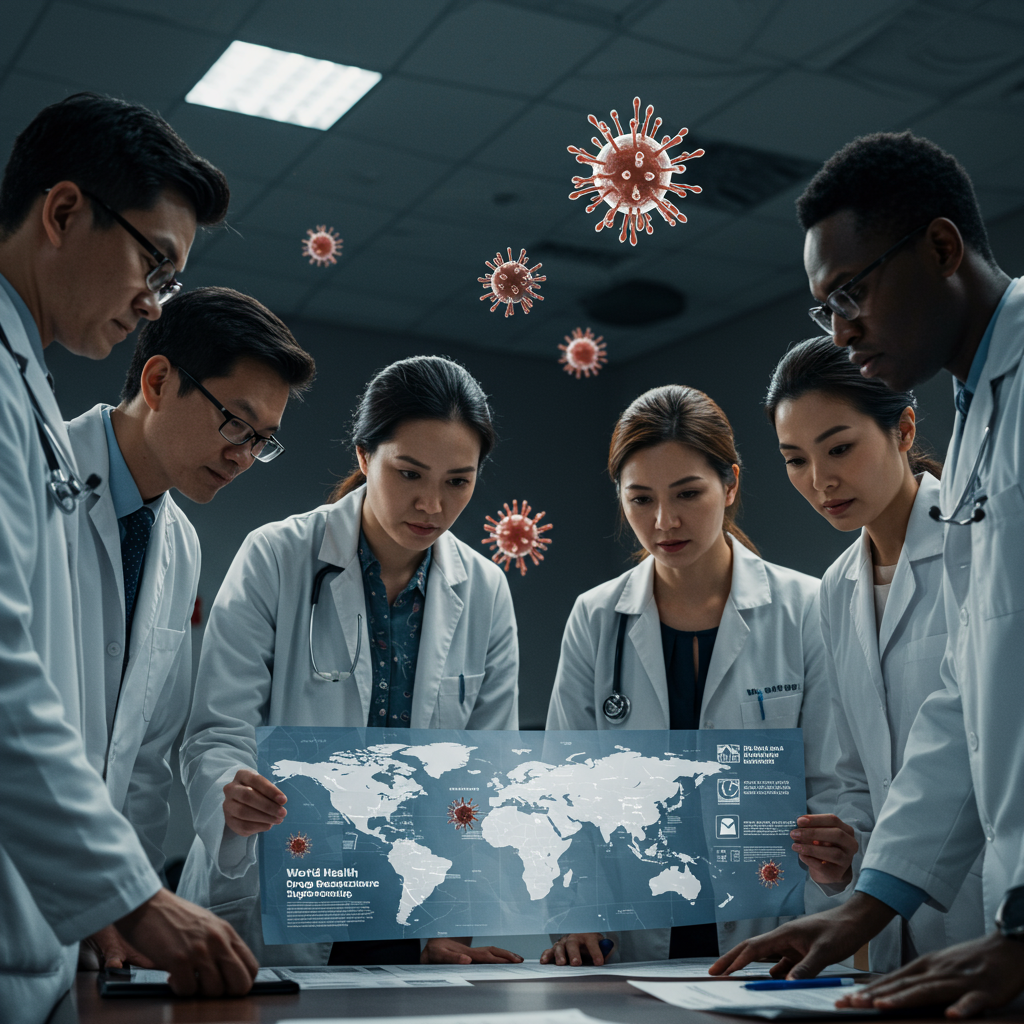The World Health Organization (WHO) has issued a dire warning: the global surge in drug-resistant superbugs is critically compromising life-saving medical treatments. Once-minor injuries and common infections are becoming potentially deadly as bacteria evolve faster than our ability to fight them. This accelerating crisis, known as antimicrobial resistance (AMR), endangers public health worldwide and demands urgent, coordinated action.
The Alarming Global Picture: A Health Emergency Unfolding
In 2023, a staggering one in six laboratory-confirmed bacterial infections globally showed resistance to standard antibiotic treatments. These findings are “deeply concerning,” according to Yvan J-F. Hutin, head of the WHO’s antimicrobial resistance department. He emphasized that as antibiotic resistance continues its alarming rise, treatment options are dwindling, putting countless lives at risk. WHO Chief Tedros Adhanom Ghebreyesus added that AMR is “outpacing advances in modern medicine, threatening the health of families worldwide.”
The scale of the problem is immense: antimicrobial-resistant superbugs are directly responsible for over a million deaths annually and contribute to nearly five million more. The WHO’s latest surveillance report, which analyzed resistance estimates for 22 antibiotics across various infection types, painted a grim picture:
Significant Increase: In the five years leading up to 2023, antibiotic resistance increased in over 40% of the monitored antibiotics, with an average annual rise of 5% to 15%. In some African nations, this surge exceeded 70%.
Common Infections Hit Hard: Resistance to commonly-used antibiotics for urinary tract infections typically exceeded 30% globally.
Deadly Pathogens: More than 40% of E. coli infections and over 55% of K. pneumoniae infections worldwide are now resistant to third-generation cephalosporins—the first-choice treatment for these severe bloodstream infections that often lead to sepsis, organ failure, and death.
The highest levels of resistance were observed in regions with weaker health systems and less surveillance. Southeast Asia and the Eastern Mediterranean reported resistance in one out of three infections, while the African region saw resistance in one out of five.
The U.S. Frontline: A Surge in “Nightmare Bacteria”
The crisis is not confined to developing nations; high-income countries, including the United States, face an acute threat. The Centers for Disease Control and Prevention (CDC) reported a nearly 70% jump in infection rates from drug-resistant “nightmare bacteria” between 2019 and 2023.
A particular concern is the dramatic rise of NDM-producing carbapenem-resistant Enterobacterales (NDM-CRE). These superbugs carry the New Delhi metallo-beta-lactamase (NDM) enzyme, which confers resistance to almost all available antibiotics, making them exceptionally difficult to treat and often fatal.
Exponential Growth: NDM-CRE infections surged by over 460% in the U.S. between 2019 and 2023.
Widespread Impact: In 2020, NDM-CRE was linked to approximately 12,700 infections and 1,100 deaths in the U.S.
Broader AMR Burden: Annually, over 2.8 million antimicrobial-resistant infections occur in the U.S., resulting in more than 35,000 deaths.
Escalating Cost: Treating infections from just six common resistant germs costs the U.S. healthcare system over $4.6 billion each year.
Dr. Maroya Walters, a CDC report author, warned that common, easily treatable infections like UTIs could become chronic, intractable health problems. David Weiss, an Emory University infectious diseases researcher, labeled the rise of NDMs in the U.S. as a “grave danger.” He and Dr. Jason Burnham, a Washington University researcher, speculate this increase is likely tied to a “huge surge in antibiotic use during the pandemic.”
Detroit’s Acute Risk: A Localized Challenge
Specific communities face magnified risks. Detroit, for instance, is identified as particularly vulnerable. Dr. Teena Chopra, an infectious diseases expert at Wayne State School of Medicine, highlights the city’s unique challenges: a majority Black population experiencing higher rates of chronic health conditions like obesity, diabetes, and high blood pressure, often requiring antibiotic use. If antibiotics become ineffective, these conditions could swiftly turn fatal. Detroit also has a historical connection to drug-resistant bacteria, with one of the first reported U.S. outbreaks occurring there in the early 1980s. Social disparities, including limited access to doctors, mean people may delay seeking treatment, allowing infections to worsen and spread.
Understanding the Drivers of Resistance: Why Superbugs Thrive
The evolution of drug-resistant superbugs is a complex phenomenon driven by multiple factors. Bacteria inherently develop resistance as a survival mechanism, but human practices have drastically accelerated this process:
Antibiotic Overuse and Misuse: The massive, and often indiscriminate, use of antibiotics in humans, animals, and food production creates an environment where resistant strains are selected and proliferate. This includes unnecessary prescriptions for viral infections and incomplete treatment courses.
Environmental Factors: Pollution and other environmental stressors contribute to conditions where microorganisms develop and spread resistance. Exposure can occur through contaminated water, food, and even fungal spore inhalation.
Limited Surveillance: Globally, 48% of countries still do not report any AMR data, leaving health authorities “flying blind,” as Yvan J-F. Hutin acknowledged. This lack of comprehensive data hinders effective monitoring and response.
Weak Health Systems: Regions with less robust healthcare infrastructure may lack the capacity for accurate diagnosis, effective treatment, and proper infection control, contributing to higher resistance rates.
Dwindling Pipeline: There is a significant “future threat” due to an insufficient pipeline of new tests and treatments. The development of novel antibiotics isn’t always profitable for pharmaceutical companies, creating a “very dangerous combination” of increasing antibiotic use, rising resistance, and a reduction in new drugs.
Strategies to Fight Back: A Multi-Pronged Global Approach
Combating the antimicrobial resistance crisis requires a comprehensive and multi-sectoral approach. The WHO advocates for robust actions:
Enhancing Data and Surveillance
Global Reporting: The WHO aims to achieve more reliable data generation, especially from underserved areas, by 2030. Improved surveillance is critical to track resistance patterns and guide interventions. Silvia Bertagnolio, head of the WHO’s AMR surveillance unit, noted that limited data can skew reported resistance rates.
Responsible Antibiotic Use
Patient Education: Individuals must use antibiotics only when prescribed by a doctor and complete the full course, even if symptoms improve. Never self-medicate or share antibiotics.
Healthcare Stewardship: Medical professionals need to differentiate between viral and bacterial infections to avoid unnecessary antibiotic prescriptions. Antibiotic stewardship programs, common in U.S. hospitals, educate staff on appropriate antibiotic use.
Innovation and Investment
Research & Development: Increased federal funding is crucial for research into new treatments, diagnostics, and preventative measures.
Incentivizing New Drugs: Investments and incentives are vital to encourage pharmaceutical companies to develop novel antibiotics, like ceftazidime-avibactam or meropenem-vaborbactam, and rapid point-of-care molecular tests.
Policy and Public Health Initiatives
Standardized Use in Livestock: Establishing worldwide standards for antibiotic use in farm animals is essential to reduce resistance development in agriculture.
Legislation: Implementing legislation requiring scientists and healthcare facilities to report resistant bacteria can improve data collection and public health response.
Infection Control: Improving sanitization in healthcare settings and public spaces, along with early diagnosis and treatment, particularly for immunocompromised patients, can prevent rapid spread.
Frequently Asked Questions
What are drug-resistant superbugs, and why is their global surge a critical threat?
Drug-resistant superbugs are bacteria that have evolved the ability to withstand the effects of antibiotics, making infections they cause extremely difficult, if not impossible, to treat. Their global surge poses a critical threat because it renders life-saving medical treatments ineffective, turning common infections and minor injuries into potentially fatal conditions. The WHO reports one in six bacterial infections in 2023 were resistant, contributing to millions of deaths annually, and undermining the foundations of modern medicine. This escalating resistance risks a return to an era where simple infections were deadly.
What international and national efforts are underway to combat the rise of antimicrobial resistance (AMR)?
International efforts, led by the WHO, focus on improving global surveillance, with a goal to generate more reliable data from underserved regions by 2030. They advocate for responsible antibiotic use and investment in new research. Nationally, the U.S. CDC monitors “nightmare bacteria” like NDM-CRE, providing critical data on their spread. Efforts also include promoting antibiotic stewardship programs in hospitals, legislating reporting of resistant bacteria, setting standards for antibiotic use in livestock, and fostering R&D for new drugs and diagnostics. However, a significant challenge remains in the pipeline for new treatments.
How can individuals contribute to preventing the spread of drug-resistant superbugs?
Individuals play a crucial role in preventing the spread of drug-resistant superbugs. The most important action is to use antibiotics responsibly: only take them when prescribed by a doctor, do not demand them for viral infections (like colds or flu), and always complete the full course of treatment, even if you feel better. Additionally, practicing good hygiene, such as frequent handwashing, staying up-to-date on vaccinations, and ensuring food safety, can reduce the risk of infection. Promptly seeking medical attention for persistent symptoms and differentiating between viral and bacterial illnesses also helps avoid unnecessary antibiotic prescriptions.
Securing Our Future Health: A Call to Action
The escalating threat of drug-resistant superbugs represents one of the most pressing public health challenges of our time. It jeopardizes our ability to treat common illnesses, perform surgeries, and manage chronic diseases. The warnings from the WHO and CDC are clear: without decisive, coordinated, and immediate action from governments, healthcare providers, researchers, and individuals, the gains of modern medicine could be undone. Investing in surveillance, responsible antibiotic use, and the development of new treatments is not just a medical imperative; it is an investment in global health security and the well-being of future generations. The time to act is now.



